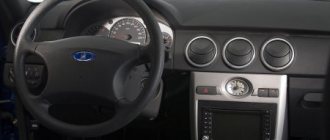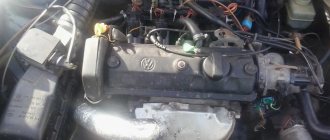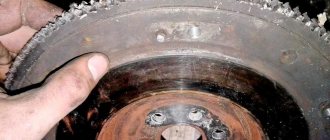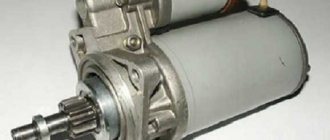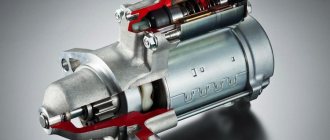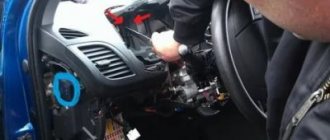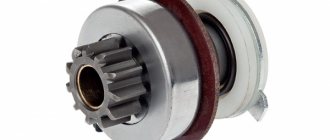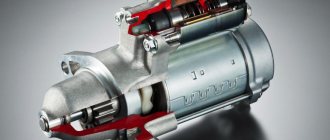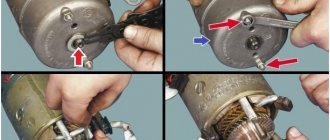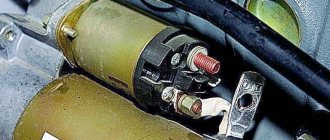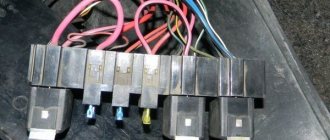Nothing brought early cars closer to mass appeal than the invention of the electric starter: the starting handle was both inconvenient and unsafe. Over more than a hundred years of use, the design of automobile starters has been “polished” almost perfectly, but even now it causes problems. The most typical of them is clicking noises under the hood when starting the engine, but the starter does not turn the engine.
Starter design
Regardless of the specific design (geared/gearless, with or without a stator winding), the electric starter includes a solenoid relay. This electromechanical unit performs two functions simultaneously:
- It pushes the bendix and drive gear forward, allowing it to mesh with the flywheel ring gear.
- It relieves the load on the ignition switch contacts: the current consumed by the starter is large, and the solenoid relay allows you to control the starter using a relatively small current.
The design of the solenoid relay is simple: its body houses two windings of different power, which draw in (hence the name) the core. A fork is installed on the core, which moves the bendix through a lever, and at the end of the stroke the core closes power contacts (“nickels”) that supply power to the starter directly from the battery. Two windings are used to reduce current consumption: more force is required to retract the core than to hold it in place. As soon as the core of the pull-in relay closes the “nickels”, the pull-in winding is bypassed, and only the holding winding works.
conclusions
There are several malfunctions due to which, when trying to start, the starter clicks but does not turn. A motorist can diagnose any of them without the use of specialized equipment.
All breakdowns can be divided into 2 groups – electric starter faults and electrical wiring faults. In the first case, dismantling of the unit is required. If the electrical wiring is broken, there is no need to remove the starter from its seat.
Has your car ever experienced a situation where the starter clicks but does not turn? What caused it to fail? How did you solve this problem?
The starter clicks, but does not turn - the reasons and methods for checking are in the video below. Replacing the starter solenoid relay:
Causes of clicking noises when starting the engine, checking and solving the problem
Solenoid relay malfunctions
Thus, it is not difficult to think of reasons why the click of the retractor relay may not be accompanied by activation of the starter. The simplest of them is power problems: dead battery, oxidized terminals. At the moment when the solenoid relay turns on the starter winding, a sharp drop in voltage occurs, and with it, in strict accordance with Ohm’s law, the current in the holding winding. The energy of the magnetic field is no longer enough to counteract the retractor return spring, and the core moves outward, breaking the starter circuit. Depending on the condition of the car and the battery, this results in either a single click from the starter or a “machine-gun burst” of clicks from under the hood.
Therefore, the first thing you should check is the battery charge, inspect the terminals on the battery and, if necessary, clean them. Having already guaranteed the supply of electricity “as intended,” we proceed to further verification.
Main symptoms of malfunctions
So, what to do in such a situation, and where to look for the problem, if you got behind the wheel of a car and turned the key in the ignition, but this did not give the desired result. The reasons may lie in the battery itself, or malfunctions of the starter, or in various connections and switching. Most often, of course, the culprit is the battery itself. It may simply discharge, and the following signs will indicate this:
- the retractor relay clicks, but the starter does not rotate, but the lights on the dashboard go out;
- the same thing, but this time a series of repeated clicks occurs;
- no movement at all, that is, even the lighting devices do not work.
Mechanical problems
Rarely on cars with high mileage is it possible for the Bendix to simply stick into the crown tooth. Initially, both the flywheel ring gear and the Bendix teeth have lead-in chamfers, allowing the gears to mesh even if the Bendix tooth does not precisely fit into the gap between the flywheel teeth. Wear over time leads to dulling of the lead-in chamfers, and a situation is possible when a Bendix tooth rests against a flywheel tooth, preventing the retractor relay core from reaching the end of the stroke and closing the power contacts.
You can “revive” the car simply: either short-circuit the terminals on the solenoid relay so that the rotor turns to a different position, or, if there is no convenient access to the starter, turn the crankshaft itself by the generator or power steering pulley using a socket and ratchet. But this is an “emergency” method - you should not postpone repairs, since similar problems will continue in the future.
The starter clicks but does not turn, what is the reason?
Good afternoon. Many car enthusiasts are familiar with the situation when the starter clicks but does not turn. As luck would have it, such situations happen at the most inconvenient moments, for example, at gas stations or when leaving for work.
In today's article, we will tell you how to determine the malfunction and, if possible, start the car to get to the repair site.
Before telling the troubleshooting algorithm, let's look at the starter device. For clarity, watch this video:
As you can see, the starter is a regular DC motor and relay. When you turn the key in the ignition and hear a click, it is the solenoid relay that clicks (the coil and contacts at the top of the screen in the video). If the starter does not rotate, but clicks, the following options are possible:
- The battery is dead.
- starter relay failed
- The contact coins in the solenoid relay are burnt.
- The starter brushes are worn.
- the starter armature is jammed.
- power plus is not supplied to the starter (because if there is no mass there will not even be retractor clicks)
Below we will analyze each of these faults in detail, and tell you which faults will allow you to start the car on the spot, using the existing starter, in order to get to the service station.
A severely discharged battery is the most common cause of clicking noises when turning the ignition key.
The error looks like this:
In our video you can see that when starting, at first, the starter barely turns the engine, and then it just crackles…. If the battery is severely discharged, the starter will not even try to crank the engine but will immediately make nasty clicking noises.
The fact is that the battery voltage is not enough even to operate the solenoid relay!
Options to solve the problem:
- light a cigarette from another car (we have a separate article about this on our website).
- start the car from a pusher/tug (if it has a manual transmission).
- remove and charge the battery.
Your starter is working!
Starter relay failure.
Relay failure manifests itself as a quiet click when turning the key.
In this case, you can start the car using a simple screwdriver. This is done like this:
Attention! If you are not confident in your abilities, you should not do this. It is better to contact specialists or call a tow truck. If you make a mistake when starting this way, the vehicle may move unintentionally or catch fire due to a short circuit.
Vehicle with manual transmission:
- set the parking brake.
- turn on neutral gear.
- open the hood and prepare a flathead screwdriver.
- turn the key in the ignition switch to the ignition on position.
- Using a screwdriver, we close two contacts on the solenoid relay (as in the video).
- After starting the engine, remove the screwdriver and drive to the repair site.
Car with automatic (+variator and robot) gearbox:
- install a car parking brake (for robot and variator).
- open the hood and prepare a screwdriver (possibly two).
- turn the ignition to the on position, press the brake, move the gear selector to the parking position (P).
- Using a screwdriver, we close two contacts on the solenoid relay (as in the video).
- After starting the engine, remove the screwdriver and drive to the repair site.
The contact coins in the solenoid relay are burnt.
This malfunction manifests itself in the form of loud clicks when the key is turned to the start position and the key is released. In some cases, the starter may trip.
Here is a video example of such a malfunction:
How to quickly diagnose contact patches?
Everything is extremely simple - open the hood, take a screwdriver, and bridge these two terminals:
If a spark jumps when the connection is made and you hear the sound of the electric starter rotating, you can be sure that your contact pins are burnt.
In this case, the car can be started with a screwdriver!
How to start a car with the starter when the contact pins burn?
Attention! If you are not confident in your abilities, you should not do this. It is better to contact specialists or call a tow truck. If you make a mistake when starting this way, the vehicle may move unintentionally or catch fire due to a short circuit.
In order to start the car when the contact pins burn out, you must simultaneously bridge all three contacts on the solenoid relay.
Closing the two contacts under the nuts is necessary to rotate the armature, and closing the control contact so that the overrunning clutch (Bendix) engages with the flywheel.
The procedure for starting a car if the contact pins fail:
Vehicle with manual transmission:
- set the parking brake.
- turn on neutral gear.
- open the hood and prepare a flathead screwdriver.
- turn the key in the ignition switch to the ignition on position.
- Using a screwdriver, we close all three contacts on the solenoid relay (sometimes one screwdriver is not enough and you have to take two).
- After starting the engine, remove the screwdriver and drive to the repair site.
Car with automatic (+variator and robot) gearbox:
- install a car parking brake (for robot and variator).
- open the hood and prepare a screwdriver (possibly two).
- turn the ignition to the on position, press the brake, move the gear selector to the parking position (P).
- Using a screwdriver, we close all three contacts on the solenoid relay (sometimes one screwdriver is not enough and you have to take two).
- After starting the engine, remove the screwdriver and drive to the repair site.
The starter brushes are worn.
The malfunction manifests itself in the same way as burning of the contact coins (loud clicks when turning the ignition key), the only difference is that when the brushes wear out, the starter will never rotate.
This is checked in the same way when bridging the contacts of the solenoid relay with a screwdriver.
like in this picture:
The starter does not start to spin, it is sincerely not observed.
How to start the car?
Unfortunately, it is impossible to start the car with this starter; it must either be repaired or replaced.
If the car is equipped with a manual transmission, it may be possible to start it by push or tow.
If the car is equipped with an automatic transmission, it makes sense to call a tow truck or tow truck.
The starter armature is jammed.
The author of the article has encountered such a malfunction several times, but, as a rule, the brushes immediately become unusable and, without analysis, you will not be able to distinguish between armature jamming and brush wear.
If, by some miracle, the brushes hold up, then when you turn the key to the start position, you will hear a very loud click, and then, for a while, all the devices will go out (you may feel a specific smell)! Burning out of the mass manifests itself in exactly the same way!
In any case, the car will not go anywhere on its own. It is necessary to carry out diagnostics and use a tow truck/tug to proceed to the repair or parking area.
No power plus is supplied to the starter.
For clarity, look at this picture:
Without a test light or multimeter, you will not determine this malfunction! And in general, without instruments, it can be confused with brush wear!
As you can see, if the power wire running from the battery to the solenoid relay breaks, the starter will not work, but the solenoid relay will click.
If, upon visual inspection of the direct battery-starter wire, you do not see any damage, call a tow truck and go to the place of repair and diagnostics.
That's all for me today. Don't let the situation where the starter clicks but doesn't turn happen to you anymore. If you have any questions or if you want to add to the article, write comments!
Best regards, administrator
Share
Clicking sounds are heard, but the starter does not turn due to the windings or brush assembly
If the battery, ignition switch, contacts, wiring and starter relay are checked, but it still does not rotate when you turn the ignition key, then the problem is directly in the starter. In such a situation, you will have to completely remove it from the car, disassemble it and evaluate the possibility of repairs. You can also simply replace the starter with a new one.
If you decide to repair the starter yourself, know that the problem with it refusing to rotate under load may be due to:
Starters are rarely repaired, and such a step should only be taken as a last resort. If it is possible to replace the starter, then it is better to do this than to bother with repairing the winding or brush assembly.
Where to look for the reason?
Knowing the operating principle of the entire circuit, you can easily identify those elements of the circuit with which problems may arise. These include:
- battery;
- wires and their connections;
- egnition lock;
- solenoid relay;
- power electric motor;
It is in this order that the circuit should be checked when looking for the cause.
Battery
Let's start with the battery. One of the reasons for the starter not turning on is a low battery. As a result, its energy is simply not enough to make the electric motor work, although there is enough of it to operate the relay (hence the clicks). An indirect sign of a discharged battery is a strong dimming of the control lamps on the dashboard when trying to turn on the starter.
The second problem with the battery is unreliable fixation of the terminals or their severe oxidation. Because of this, the contact is insufficient and strong resistance occurs, so the required amount of energy does not flow to the starter.
If everything is in order with the battery, we move on to the wires. First of all, you should check the reliability of fastening and the integrity of the “positive” wire to the battery and the relay terminal, as well as the engine ground. It is noteworthy that for some reason many car enthusiasts ignore checking the ground connection, so they cannot find the reason for a long time.
Video: Maxus LDV Maxus starter clicks, does not turn
Wiring, ignition switch
Let's move on to the power wires of the solenoid relay going to the lock. Here, by the way, you can do it easier by checking the entire circuit at once in one simple operation:
- We put the car in “neutral” gear and tighten the handbrake.
- Open the hood and provide access to the solenoid relay terminals.
- We take a screwdriver or a small key and use them to connect the power supply terminals of the electric motor.
UAZ Bukhanka starter sticks
I give you the exact recipe. I'm 99% sure it will help. Because I had this happen, I suffered for a long time, I rebuilt the starter, changed the bendex, checked the mass. well, etc.
Change the battery. Moreover, do not try to charge, recharge, or measure the density. In modern times, this is, in principle, a thankless and useless task. A “skay” came to him. I know that it sounds somewhat paradoxical, but this feature takes place on the 402nd.
By the way, using the same advice, I cured two more Volga acquaintances. Which suggests a certain pattern :)
And frankly, I don’t fully understand why this is so.
I installed another starter! The current started to start again. yeah, same thing! I adjusted the ignition again, turned the octane adjuster, it seemed to have stopped (but what if it’s a coincidence, I see a train). There is a doubt about the play in the distributor, if you take it by the slider and turn it, the play is about 1-1.5 cm (and in one direction) around the circumference, if you look at the stator there is a play of 1-2 mm, I don’t even know if this is normal. unsure:
This is normal for the distributor; this is a backlash in the vacuum and inertial corrector
I give you the exact recipe. I'm 99% sure it will help. Because I had this happen, I suffered for a long time, I rebuilt the starter, changed the bendex, checked the mass. well, etc.
Change the battery. Moreover, do not try to charge, recharge, or measure the density. In modern times, this is, in principle, a thankless and useless task. A “skay” came to him. I know that it sounds somewhat paradoxical, but this feature takes place on the 402nd.
By the way, using the same advice, I cured two more Volga acquaintances. Which suggests a certain pattern :)
And frankly, I don’t fully understand why this is so.
Of course, the new one will foolishly push the engine and the old one will forcefully, but this is eliminating the effect and not the cause
My starter was stuck, I double-checked everything, but it turned out that it was sticking to the stator with its armature and was still eating an incredible amount of dirt. I fixed it by replacing the bushings on the starter! Unfortunately, a year later, the starter still stuck. Another time, one of the four starter brushes got stuck.
Source
Brushes and winding
Inside the starter housing there are 4 steel cores (shoes) with a winding that is connected into a circuit.
Healthy! Some cars do not use cores with windings, but magnets, which is much more convenient.
The current to the winding comes from the central input, and the output is output to two copper-graphite positive brushes that go to the commutator. Also connected to it are negative brushes that come from the starter mass. All brushes are constantly pressed using small springs. But, since graphite is not the most durable material, these elements tend to wear out quite quickly. When brush wear reaches a critical level, the solenoid relay stops receiving current.
In the event of such a breakdown, the starter will not make any extraneous sounds. To repair, you will need to disassemble it and evaluate the condition of the brushes. If everything is in order with them, then we look at the windings. If they burn out, the layer of varnish that is applied to them will also burn out. Also, instead of copper color, the windings will be black. An unpleasant burning smell also indicates a problem. In this case, the best thing would be to replace the entire assembly, although you can get by with new windings.
It won't start, it rattles...
The car suddenly refused to start...
I left it for the whole day, came back, all the lights were on, the starter was crackling, as if the battery had died completely. I checked the light - it burns brightly, the high beam is brighter than the low beam... The car is a 2001 Honda Civic. Hatch. Does anyone know what could be happening??
the sound of a crack is hard to hear, it’s not clear

